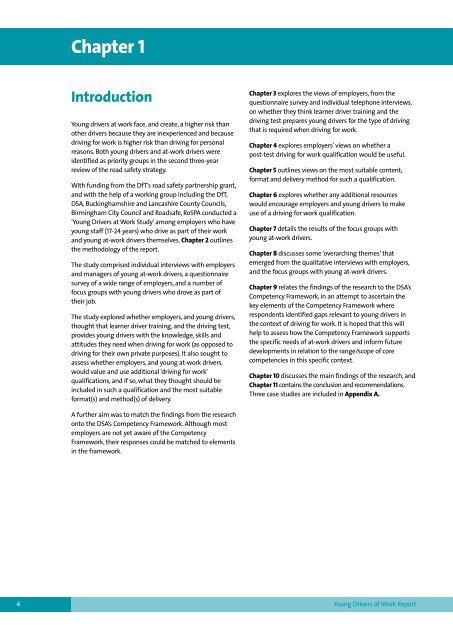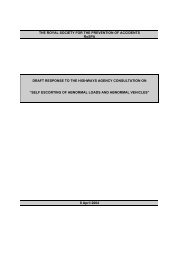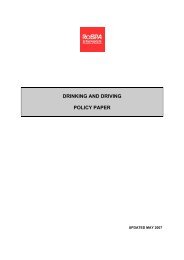RoSPA Young Drivers at Work Report
RoSPA Young Drivers at Work Report
RoSPA Young Drivers at Work Report
Create successful ePaper yourself
Turn your PDF publications into a flip-book with our unique Google optimized e-Paper software.
Chapter 1<br />
Introduction<br />
<strong>Young</strong> drivers <strong>at</strong> work face, and cre<strong>at</strong>e, a higher risk than<br />
other drivers because they are inexperienced and because<br />
driving for work is higher risk than driving for personal<br />
reasons. Both young drivers and <strong>at</strong>-work drivers were<br />
identified as priority groups in the second three-year<br />
review of the road safety str<strong>at</strong>egy.<br />
With funding from the DfT’s road safety partnership grant,<br />
and with the help of a working group including the DfT,<br />
DSA, Buckinghamshire and Lancashire County Councils,<br />
Birmingham City Council and Roadsafe, <strong>RoSPA</strong> conducted a<br />
‘<strong>Young</strong> <strong>Drivers</strong> <strong>at</strong> <strong>Work</strong> Study’ among employers who have<br />
young staff (17-24 years) who drive as part of their work<br />
and young <strong>at</strong>-work drivers themselves. Chapter 2 outlines<br />
the methodology of the report.<br />
The study comprised individual interviews with employers<br />
and managers of young <strong>at</strong>-work drivers, a questionnaire<br />
survey of a wide range of employers, and a number of<br />
focus groups with young drivers who drove as part of<br />
their job.<br />
The study explored whether employers, and young drivers,<br />
thought th<strong>at</strong> learner driver training, and the driving test,<br />
provides young drivers with the knowledge, skills and<br />
<strong>at</strong>titudes they need when driving for work (as opposed to<br />
driving for their own priv<strong>at</strong>e purposes). It also sought to<br />
assess whether employers, and young <strong>at</strong>-work drivers,<br />
would value and use additional ‘driving for work’<br />
qualific<strong>at</strong>ions, and if so, wh<strong>at</strong> they thought should be<br />
included in such a qualific<strong>at</strong>ion and the most suitable<br />
form<strong>at</strong>(s) and method(s) of delivery.<br />
Chapter 3 explores the views of employers, from the<br />
questionnaire survey and individual telephone interviews,<br />
on whether they think learner driver training and the<br />
driving test prepares young drivers for the type of driving<br />
th<strong>at</strong> is required when driving for work.<br />
Chapter 4 explores employers’ views on whether a<br />
post-test driving for work qualific<strong>at</strong>ion would be useful.<br />
Chapter 5 outlines views on the most suitable content,<br />
form<strong>at</strong> and delivery method for such a qualific<strong>at</strong>ion.<br />
Chapter 6 explores whether any additional resources<br />
would encourage employers and young drivers to make<br />
use of a driving for work qualific<strong>at</strong>ion.<br />
Chapter 7 details the results of the focus groups with<br />
young <strong>at</strong>-work drivers.<br />
Chapter 8 discusses some ‘overarching themes’ th<strong>at</strong><br />
emerged from the qualit<strong>at</strong>ive interviews with employers,<br />
and the focus groups with young <strong>at</strong>-work drivers.<br />
Chapter 9 rel<strong>at</strong>es the findings of the research to the DSA’s<br />
Competency Framework, in an <strong>at</strong>tempt to ascertain the<br />
key elements of the Competency Framework where<br />
respondents identified gaps relevant to young drivers in<br />
the context of driving for work. It is hoped th<strong>at</strong> this will<br />
help to assess how the Competency Framework supports<br />
the specific needs of <strong>at</strong>-work drivers and inform future<br />
developments in rel<strong>at</strong>ion to the range/scope of core<br />
competencies in this specific context.<br />
Chapter 10 discusses the main findings of the research, and<br />
Chapter 11 contains the conclusion and recommend<strong>at</strong>ions.<br />
Three case studies are included in Appendix A.<br />
A further aim was to m<strong>at</strong>ch the findings from the research<br />
onto the DSA’s Competency Framework. Although most<br />
employers are not yet aware of the Competency<br />
Framework, their responses could be m<strong>at</strong>ched to elements<br />
in the framework.<br />
4 <strong>Young</strong> <strong>Drivers</strong> <strong>at</strong> <strong>Work</strong> <strong>Report</strong>
















